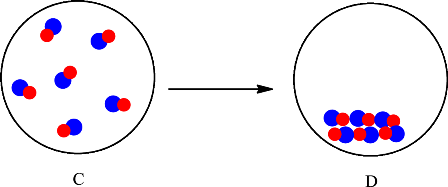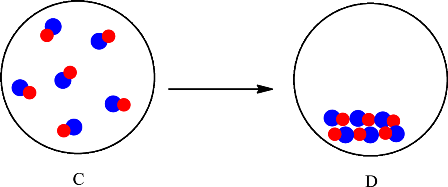
Concept explainers
(a)
Interpretation:
Whether the following change is physical or chemical is to be determined.
Concept introduction:
The change that takes place only in state or appearance and not in the composition is known as physical change. The atoms or the molecules of a substance do not change their identity when a substance undergoes a physical change. The change accompanied by the change in the physical properties only is classified as physical change. The substance remains the same before and after the change. For example, the melting of ice is a physical change.
The change that takes place in the composition is known as chemical change. The atoms or the molecules of the substance rearrange and transformed into a new substance. For example, the burning of paper is a chemical change.
(a)
Answer to Problem 1.1P
The mixing of substances in A and B to give substance in C is a chemical change.
Explanation of Solution
The change is depicted as follows:

Each sphere represents one particle or atom. Atoms from A react with the atoms in B to form a new substance with one red and one blue atom depicted in the C. Formation of a new substance in a change is classified as a chemical change. Thus, the mixing of substances in A and B to give substance in C is a chemical change.
The particles in the A interact with the particles in B and result in the formation of new substance (change in composition). Therefore, it can be classified as a chemical change.
(b)
Interpretation:
Whether the following change is physical or chemical is to be determined.
Concept introduction:
The change that takes place only in state or appearance and not in the composition is known as physical change. The atoms or the molecules of a substance do not change their identity when a substance undergoes a physical change. The change accompanied by the change in the physical properties only is classified as physical change. The substance remains the same before and after the change. For example, the melting of ice is a physical change.
The change that takes place in the composition is known as chemical change. The atoms or the molecules of the substance rearrange and transformed into a new substance. For example, the burning of paper is a chemical change.
(b)
Answer to Problem 1.1P
The mixing of substances in A and B to give substance in D is a chemical change.
Explanation of Solution
The change is depicted as follows:

Each sphere represents one particle or atom. Atoms from A react with the atoms in B to form a new substance with one red and one blue atom depicted in the D. Formation of a new substance in a change is classified as a chemical change. Thus, the change is classified as a physical change. Therefore, the mixing of substances in A and B to give substance in D is a chemical change.
The particles in A interact with the particles in B and result in the formation of new substance (change in composition). Therefore, it can be classified as a chemical change.
(c)
Interpretation:
Whether the following change is physical or chemical is to be determined.
Concept introduction:
The change that takes place only in state or appearance and not in the composition is known as physical change. The atoms or the molecules of a substance do not change their identity when a substance undergoes a physical change. The change accompanied by the change in the physical properties only is classified as physical change. The substance remains the same before and after the change. For example, the melting of ice is a physical change.
The change that takes place in the composition is known as chemical change. The atoms or the molecules of the substance rearrange and transformed into a new substance. For example, the burning of paper is a chemical change.
(c)
Answer to Problem 1.1P
The conversion of substance C into D is a physical change.
Explanation of Solution
The change is depicted as follows:

Each sphere represents one particle or atom. C consists of molecules made up of one red sphere and one blue sphere. D also consists of molecules made up of one red sphere and one blue sphere. The only difference is in the arrangement of the particles in C and D. In C the particles are far apart from each other and are in the gaseous state whereas in D the particles are arranged in a regular pattern and in the solid state. Since no new substance is formed, therefore conversion of substance C into D is considered as a physical change.
The particles in C rearranged to give substance D. Since no new substance is formed the change is classified as a physical change.
(d)
Interpretation:
Whether the following change is accompanied by the change in physical properties or chemical properties is to be determined.
Concept introduction:
The change that takes place only in state or appearance and not in the composition is known as physical change. The atoms or the molecules of a substance do not change their identity when a substance undergoes a physical change. The change accompanied by the change in the physical properties only is classified as physical change. The substance remains the same before and after the change. For example, the melting of ice is a physical change.
The change that takes place in the composition is known as chemical change. The atoms or the molecules of the substance rearrange and transformed into a new substance. For example, the burning of paper is a chemical change.
(d)
Answer to Problem 1.1P
After the change in part (c) has occurred the sample have different physical properties.
Explanation of Solution
The change is depicted as follows:

Each sphere represents one particle or atom. C consists of molecules made up of one red sphere and one blue sphere. D also consists of molecules made up of one red sphere and one blue sphere. The only difference is in the arrangement of the particles in C and D. In C the particles are far apart from each other and are in the gaseous state whereas in D the particles are arranged in a regular pattern and in the solid state. Since no new substance is formed, therefore conversion of substance C into D is considered as a physical change.
The change is physical change, therefore, substance C and D will have the same chemical properties but different physical properties.
The particles in C rearranged to give substance D. Since no new substance is formed the substance C and D are the same therefore they will have the same chemical properties but different physical properties.
Want to see more full solutions like this?
Chapter 1 Solutions
CHEMISTRY:MOLECULAR NATURE...-ALEKS 360
- 8:16 PM Sun Mar 30 K Draw the major product of this reaction. Ignore inorganic byproducts. Proble 1. CH3MgBr 2. H3O+ F Drawingarrow_forwardо но оarrow_forwardName the major organic product of the following action of 4-chloro-4-methyl-1-pentanol in neutral pollution 10+ Now the product. The product has a molecular formula f b. In a singly hain, the starting, material again converts into a secule with the molecular kormula CIO. but with comply Draw the major organic structure inhalationarrow_forward
- Macmillan Learning Alcohols can be oxidized by chromic acid derivatives. One such reagent is pyridinium chlorochromate, (C,H,NH*)(CICTO3), commonly known as PCC. Draw the proposed (neutral) intermediate and the organic product in the oxidation of 1-butanol by PCC when carried out in an anhydrous solvent such as CH₂C₁₂. PCC Intermediate OH CH2Cl2 Draw the intermediate. Select Draw Templates More с H Cr о Product Draw the product. Erase Select Draw Templates More H о Erasearrow_forwardIf I have 1-bromopropene, to obtain compound A, I have to add NaOH and another compound. Indicate which compound that would be. A C6H5 CH3arrow_forwardProvide the reagents for the following reactions.arrow_forward
- If I have 1-bromopropene, to obtain compound Z, I have to add two compounds A1 and A2. Indicate which compounds are needed. P(C6H5)3arrow_forwardDraw the major product of this reaction. Ignore inorganic byproducts. Assume that the water side product is continuously removed to drive the reaction toward products. O CH3CH2NH2, TSOH Select to Draw >arrow_forwardPredict the major organic product(s) for the following reaction.arrow_forward
- Predict the major organic product(s) for the following reactions.arrow_forwardProvide the complete mechanism for the reactions below. You must include appropriate arrows,intermediates, and formal charges.arrow_forwardIndicate the products obtained by reacting fluorobenzene with a sulfonitric mixture.arrow_forward
 ChemistryChemistryISBN:9781305957404Author:Steven S. Zumdahl, Susan A. Zumdahl, Donald J. DeCostePublisher:Cengage Learning
ChemistryChemistryISBN:9781305957404Author:Steven S. Zumdahl, Susan A. Zumdahl, Donald J. DeCostePublisher:Cengage Learning ChemistryChemistryISBN:9781259911156Author:Raymond Chang Dr., Jason Overby ProfessorPublisher:McGraw-Hill Education
ChemistryChemistryISBN:9781259911156Author:Raymond Chang Dr., Jason Overby ProfessorPublisher:McGraw-Hill Education Principles of Instrumental AnalysisChemistryISBN:9781305577213Author:Douglas A. Skoog, F. James Holler, Stanley R. CrouchPublisher:Cengage Learning
Principles of Instrumental AnalysisChemistryISBN:9781305577213Author:Douglas A. Skoog, F. James Holler, Stanley R. CrouchPublisher:Cengage Learning Organic ChemistryChemistryISBN:9780078021558Author:Janice Gorzynski Smith Dr.Publisher:McGraw-Hill Education
Organic ChemistryChemistryISBN:9780078021558Author:Janice Gorzynski Smith Dr.Publisher:McGraw-Hill Education Chemistry: Principles and ReactionsChemistryISBN:9781305079373Author:William L. Masterton, Cecile N. HurleyPublisher:Cengage Learning
Chemistry: Principles and ReactionsChemistryISBN:9781305079373Author:William L. Masterton, Cecile N. HurleyPublisher:Cengage Learning Elementary Principles of Chemical Processes, Bind...ChemistryISBN:9781118431221Author:Richard M. Felder, Ronald W. Rousseau, Lisa G. BullardPublisher:WILEY
Elementary Principles of Chemical Processes, Bind...ChemistryISBN:9781118431221Author:Richard M. Felder, Ronald W. Rousseau, Lisa G. BullardPublisher:WILEY





